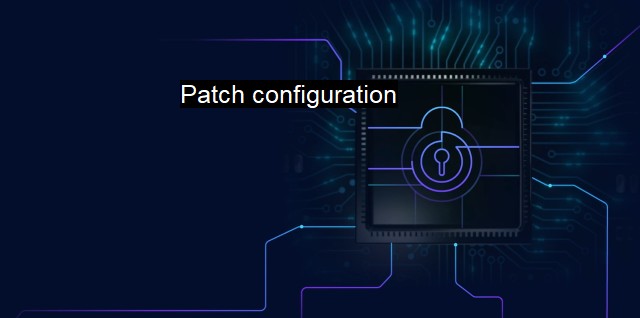What is Patch configuration?
The Importance of Patch Configuration in Cybersecurity: Mitigating Vulnerabilities to Prevent Cyber Attacks and Protect Sensitive Data
Patch configuration, within the context of cybersecurity and antivirus models, refers to the process of updating software systems, specifically on a target or victim computer, to resolve, fix, or improve any identified vulnerabilities, bugs, or issues. It involves altering the system software to bring about desired changes, which can include updating utilities, modifying infrastructures, data validation, improving security features, or changes in the software operation.Successful patch configuration results in an updated software system, typically providing them with necessary protection against security vulnerabilities. These vulnerabilities, also known as "security holes", can be exploited by cyber threat actors such as hackers, who bypass system defense mechanisms, steal data, install malicious software, or perform other harmful activities.
An effective patch configuration involves diligently tracking changes, testing new patches before implementing, backing up data before patching, and ensuring expedient implementation to prevent possible attacks.
It is critical to note that patch configurations are not a one-time process. They are a continuous and systematic undertaking, which should be done from time to time following the advancement in technology and the evolution of contemporary threats. Every software, irrespective of its intent, be it system software such as an operating system or application software as basic as a media player, frequently has vulnerabilities that need patching.
One major application of patch configuration involves antivirus software. Every antivirus software must be timely and accurately updated because it is pivotal in warding off malware and safeguarding sensitive data. Well-configured antivirus software maximizes the protection capabilities for users. When surfacing vulnerabilities are corrected through patches, the probability of being impacted by a new virus, ransomware, or other forms of cybersecurity attacks is greatly minimized, allowing the user to harness the full capacity of digital platforms effectively and securely.
Patch configuration also has its challenges. One major setback is the risk of conflicts between the patch and the existing system in operation, leading to potential system instability, crashes, or even additional security vulnerabilities. Therefore, there's a need for careful adaptation of patches that includes thorough vetting, compatibility testing, and user feedback. Developers should also be vigilant in releasing improved versions of software that accommodate the continuous discovery of bugs and potential attacks.
Patch management, which oversees patch configuration, is paramount in maintaining cybersecurity currency. They prioritize patches according to their criticality and impact on overall system performance. It's their job to guarantee that the right patches are applied to the correct system, ensuring compatibility and avoiding conflicts. For organizations, embracing patch management can benefit from preventing security mishaps, reducing patch redundancy, and boosting the overall system performance and security level.
Cybersecurity without an effective patch configuration envisages lower defense levels against breaches. It would also lead to huge losses in terms of data and other virtual resources. it helps safeguard company reputation as no one would trust a software vendor known to have vulnerabilities that go unpatched.
The role of patch configuration in cybersecurity cannot be overlooked. Companies need to continuously invest and dedicate robust resources for the successful execution of patch configuration. Whether small or large, every organization that utilizes digital platforms must develop concrete configurations and strategies to reinforce their cybersecurity posture.

Patch configuration FAQs
What is patch configuration?
Patch configuration is the process of configuring and managing patches for software applications and operating systems to improve cybersecurity and protect against vulnerabilities.Why is patch configuration important for cybersecurity?
Patch configuration is essential for cybersecurity because it helps to prevent attackers from exploiting vulnerabilities in software applications and operating systems.What are the best practices for patch configuration?
The best practices for patch configuration include regularly scanning for vulnerabilities, prioritizing critical patches, testing patches before deployment, and maintaining documentation of patch configuration.How can an antivirus program help with patch configuration?
Antivirus programs can help with patch configuration by automatically scanning for vulnerabilities and recommending necessary patches. Some antivirus programs also include patch management features that allow for the automatic deployment of patches.| | A | | | B | | | C | | | D | | | E | | | F | | | G | | | H | | | I | | | J | | | K | | | L | | | M | |
| | N | | | O | | | P | | | Q | | | R | | | S | | | T | | | U | | | V | | | W | | | X | | | Y | | | Z | |
| | 1 | | | 2 | | | 3 | | | 4 | | | 7 | | | 8 | | |||||||